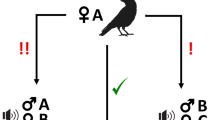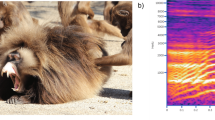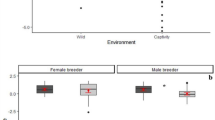Abstract
The authors analyze the effects of enrichment devices on the behavior of common marmoset female pairs, and determine which aspects of these devices are more likely to elicit explorative behaviors, and how their presence affects aggressive and stress-related behaviors. The results support the use of enrichment devices for captive primates and show that in marmosets, their effectiveness strongly depends on location within the enclosure and the presence of hidden food.
This is a preview of subscription content, access via your institution
Access options
Subscribe to this journal
We are sorry, but there is no personal subscription option available for your country.
Buy this article
- Purchase on Springer Link
- Instant access to full article PDF
Prices may be subject to local taxes which are calculated during checkout




Similar content being viewed by others
References
Wemesfelder, F. Animal Boredom: Towards an Empirical Approach of Animal Subjectivity. Thesis, University of Leiden, Utrecht, The Netherlands, 1993.
National Research Council. The Psychological Well-being of Nonhuman Primates (National Academy Press, Washington DC, 1998).
Novak, M.A. & Suomi, S.J. Psychological well-being of primates in captivity. Amer. Psychol. 43, 765–773 (1988).
Clark, A.B. in Primate Responses to Environmental Change (ed. Box, H.O.) 91–114 (Chapman & Hall, Cambridge, UK, 1991).
Schapiro, S.J., Suarez, S.A., Porter, L.M. & Bloomsmith, M.A. The effect of different types of feeding on the behaviour of single-caged, yearling rhesus macaques. Anim. Welfare 5, 129–138 (1996).
Snowdon, C.T. & Savage, A. in Housing, Care and Psychological Well-Being of Captive and Laboratory Primates (ed. Segal, E.F.) 74–88 (Noyes Publications, Park Ridge, NJ, 1989).
Scott, L. in Primate Responses to Environmental Change (ed. Box, H.O.) 265–274 (Chapman & Hall, Cambridge, UK, 1991).
Digby, L.J. & Barreto, C.E. Social organization in a wild population of Callithrix jacchus. I. Group composition and dynamics. Folia Primatol (Basel) 61, 123–134 (1993).
Koenig, A. Group size, composition and reproductive success in wild common marmosets (Callithrix jacchus). Am. J. Primatol. 35, 311–317 (1995).
Abbott, D.H., Barrett, J. & George, L.M. in Marmosets and Tamarins: Systematics, Behaviour and Ecology (ed. Rylands, A.B.) 152–162 (Oxford University Press, Oxford, UK, 1993).
Ziegler, T.E. & Sousa, M.B.C. Parent–daughter relationships and the social controls on fertility in female common marmosets, Callithrix jacchus. Horm. Behav. 42, 356–367 (2002).
Epple, G. et al. in Marmosets and Tamarins: Systematics, Behaviour and Ecology (ed. Rylands, A.B.) 123–151 (Oxford University Press, Oxford, UK, 1993).
Rothe, H. & Darms, K. in Marmosets and Tamarins: Systematics, Behaviour and Ecology (ed. Rylands, A.B.) 176–199 (Oxford University Press, Oxford, UK, 1993).
Box, H.O. & Smith, P. Age and gender differences in response to food enrichment in family groups of captive marmosets (Callithrix–Callitrichidae). Anim. Technol. 46, 11–18 (1995).
Clark, A.B. & Boinski, S. Temperament in non-human primates. Am. J. Primatol. 37, 103–125 (1995).
Millar, S.K., Evans, S. & Chamove, A.S. Older offspring contact novel objects soonest in callitrichid families. Biol. Behav. 13, 82–96 (1988).
Bayne, K.A.L. Nylon balls re-visited. Lab. Primate Newslett. 28, 5–6 (1989).
Box, H.O. in Primate Responses to Environmental Change (ed. Box, H.O.) 57–74 (Chapman & Hall, Cambridge, UK, 1991).
Poffe, A., Melotto, S. & Gerrard, P.A. Comparison of four environmental enrichment strategies in captive common marmosets (Callithrix jacchus). Primate Rep. 42, 24–25 (1995).
Sambrook, T.D. & Buchanan-Smith, H.M. What makes novel objects enriching? A comparison of the qualities of control and complexity. Lab. Primate Newslett. 35, 1–4 (1996).
Sambrook, T.D. & Buchanan-Smith, H.M. Control and complexity in novel object enrichment. Anim. Welfare 6, 207–216 (1997).
Taylor, L.L. Promoting species-typical behavior in Coquerel's sifakas (Propithecus verreauxi coquereli). American Zoo and Aquarium Association Regional Conference Proceedings (1998), pp. 599–603.
Prescott, M.J. & Buchanan-Smith, H.M. in Predator Sensitive Foraging among Primates (ed. Miller, L.) 41–57 (Cambridge University Press, Cambridge, UK, 2002).
Box, H.O. & Rohrhuber, B. Differences in behaviour among adult male, female pairs of cotton-top tamarins (Saguinus oedipus) in different conditions of housing. Anim. Technol. 44, 19–30 (1993).
Bayne, K.A.L. et al. The reduction of abnormal behaviors in individually housed rhesus monkeys (Macaca mulatta) with a foraging/grooming board. Am. J. Primatol. 23, 23–35 (1991).
Mc Gregor, P.K. & Ayling, S.J. Varied cages results in more aggression in male CFLP mice. Appl. Anim. Behav. Sci. 26, 277–281 (1990).
de Waal, F.B.M. Coping with social tension: sex differences in the effect of food provision to small rhesus monkey groups. Anim. Behav. 32, 765–773 (1984).
Michels, A.M. Sex differences in food acquisition and aggression in captive common marmosets (Callithrix jacchus). Primates 39, 549–556 (1998).
Majolo, B., Buchanan-Smith, H.M. & Morris, K. Factors affecting the successful pairing of unfamiliar common marmoset (Callithrix jacchus) females: preliminary results. Anim. Welfare (in press).
Lehner, P.N. Handbook of Ethological Methods (Cambridge University Press, Cambridge, UK, 1996).
Cilia, J. & Piper, D.C. Marmoset conspecific confrontation: an ethologically-based model of anxiety. Pharmacol. Biochem. Behav. 58, 85–91 (1997).
Johnson, E.O. et al. The biobehavioural consequences of psychogenetic stress in a small, social primate (Callithrix jacchus). Biol. Psychiatr. 40, 317–337 (1996).
Maestripieri, D., Schino, G., Aureli, F. & Troisi, A. A modest proposal: displacement activities as an indicator of emotions in primates. Anim. Behav. 44, 967–979 (1992).
Schino, G., Perretta, G., Taglioni, A.M., Monaco, V. & Troisi, A. Primate displacement activities as an ethopharmacological model of anxiety. Anxiety 2, 186–191 (1996).
Altmann, J. Observational study of behavior: sampling methods. Behaviour 49, 227–267 (1974).
Martin, P. & Bateson, P. Measuring Behaviour (Cambridge University Press, Cambridge, UK, 1993).
Everitt, B.S. Making Sense of Statistics in Psychology (Oxford University Press, Oxford, UK, 1996).
Molzen, E.M. & French, J.A. in Housing, Care and Psychological Well-being of Captive and Laboratory Primates (ed. Segal, E.F) 89–101 (Noyes Publications, Park Ridge, NJ, 1989).
Bertrand, F., Seguin, Y., Chauvier, F. & Blanquié, J.P. Influence of two different kinds of foraging devices on feeding behaviour of rhesus macaques (Macaca mulatta). Folia Primatol. 70, 207 (1999).
Stevenson, M.F. & Rylands, A.B. in Ecology and Behavior of Neotropical Primates Vol. 2 (eds. Mittermeier, R.A., Rylands, A.B., Coimbra-Filho, A.F. & da Fonseca, G.A.B.) 131–222 (World Wildlife Fund, Washington, DC, 1988).
Reinhardt, V., Liss, C. & Stevens, C. Space requirement stipulations for caged nonhuman primates in the United States: a critical review. Anim. Welfare 5, 361–372 (1996).
Buchanan-Smith, H.M., Shand, C. & Morris, K. Cage use and feeding height preferences in captive common marmosets (Callithrix jacchus jacchus) in two-tier cages. J. Appl. Anim. Welfare Sci. 5, 137–147 (2002).
Voland, E. Social play behaviour of the common marmosets (Callithrix jacchus Erxl., 1777) in captivity. Primates 18, 883–901 (1977).
Acknowledgements
We thank Keith Morris, Irene Greig, Kevin Hawes, and Mark Fisken of the MRC Unit for their practical help and kindness throughout the data collection, and Gabriele Schino and Raffaella Ventura for valuable comments on the manuscript. B.M. was funded by a University “La Sapienza” of Rome studentship, and by a grant from the Universities Federation for Animal Welfare (report number 26-00).
Author information
Authors and Affiliations
Corresponding author
Rights and permissions
About this article
Cite this article
Majolo, B., Buchanan-Smith, H. & Bell, J. Response to Novel Objects and Foraging Tasks by Common Marmoset (Callithrix jacchus) Female Pairs. Lab Anim 32, 32–38 (2003). https://doi.org/10.1038/laban0303-32
Received:
Accepted:
Issue Date:
DOI: https://doi.org/10.1038/laban0303-32



